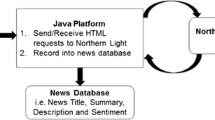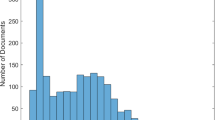Abstract
Online media are an important source for investor sentiment on commodities. Although there is empirical evidence for a relationship between investor sentiment from news and commodity returns, the impact of classifier design on the explanatory power of sentiment for returns has received little attention. We evaluate the explanatory power of nine classifier designs and find that (1) a positive relationship holds between more opinionated online media sentiment and commodity returns, (2) weighting dictionary terms by machine learning increases explanatory power by up to 25%, and (3) the commonly used dictionary of Loughran and McDonald is detrimental for commodity sentiment analysis.
Access this chapter
Tax calculation will be finalised at checkout
Purchases are for personal use only
Similar content being viewed by others
References
Shleifer, A.: Inefficient Markets: An Introduction to Behavioral Finance. Oxford University Press, New York (2000)
Feuerriegel, S., Neumann, D.: News or noise? How news drives commodity prices. In: Proceedings of the 34th International Conference on Information Systems (ICIS 2013), Milan, Italy, pp. 1–20 (2013)
Feuerriegel, S., Heitzmann, S.F., Neumann, D.: Do investors read too much into news? How news sentiment causes price formation. In: Proceedings of the 48th Hawaii International Conference on System Sciences (HICSS’ 2015), pp. 4803–4812 (2015)
Smales, L.A.: News sentiment in the gold futures market. J. Bank. Finan. 49, 275–286 (2014)
Borovkova, S., Mahakena, D.: News, volatility and jumps: the case of natural gas futures. Quant. Finan. 15(7), 1217–1242 (2015)
Alfano, S., Feuerriegel, S., Neumann, D.: Is news sentiment more than just noise? In: Proceedings of the 23rd European Conference on Information Systems (ECIS 2015), Münster, Germany, pp. 1–16 (2015)
Clements, A.E., Todorova, N.: Information flow, trading activity and commodity futures volatility. J. Futures Markets 36(1), 88–104 (2016)
Feuerriegel, S., Lampe, M.W., Neumann, D.: News processing during speculative bubbles: evidence from the oil market. In: Proceedings of the 47th Hawaii International Conference on System Sciences (HICSS 2014), pp. 4103–4112 (2014)
Loughran, T., McDonald, B.: When is a liability not a liability? Textual analysis, dictionaries, and 10-Ks. J. Finan. 66(1), 67–97 (2011)
Salton, G., Buckley, C.: Term-weighting approaches in automatic text retrieval. Inf. Process. Manage. 24(5), 513–523 (1988)
Pang, B., Lee, L., Vaithyanathan, S.: Thumbs up? Sentiment classification using machine learning techniques. In: Proceedings of the Conference on Empirical Methods in Natural Language Processing (EMNLP 2002), Philadelphia, PA, USA, pp. 79–86 (2002)
Sebastiani, F.: Machine learning in automated text categorization. ACM Comput. Surv. 34(1), 1–47 (2002)
Wang, S., Manning, C.D.: Baselines and bigrams: simple, good sentiment and topic classification. In: Proceedings of the 50th Annual Meeting of the Association for Computational Linguistics-Volume 2, Jeju, South Korea, vol. 94305, pp. 90–94 (2012)
Rao, T., Srivastava, S.: Modeling movements in oil, gold, forex and market indices using search volume index and Twitter sentiments. In: Proceedings of the 5th Annual ACM Web Science Conference, Paris, France, pp. 336–345 (2013)
Loughran, T., McDonald, B.: Loughran and McDonald financial sentiment dictionaries (2014). http://www3.nd.edu/~mcdonald/Word_Lists.html
Henry, E.: Are investors influenced by how earnings press releases are written? J. Bus. Commun. 45(4), 363–407 (2008)
Brown, G.W., Cliff, M.T.: Investor sentiment and asset valuation. J. Bus. 78(2), 405–440 (2005)
Baker, M., Wurgler, J.: Investor sentiment and the cross-section of stock returns. J. Finan. 61(4), 1645–1680 (2006)
Pan, J., Poteshman, A.M.: The information in option volume for future stock prices. Rev. Finan. Stud. 19(3), 871–908 (2006)
Joachims, T.: Text categorization with support vector machines: learning with many relevant features. In: Nédellec, C., Rouveirol, C. (eds.) ECML 1998. LNCS, vol. 1398, pp. 137–142. Springer, Heidelberg (1998). https://doi.org/10.1007/BFb0026683
Klein, A., Altuntas, O., Riekert, M., Dinev, V.: Combined approach for extracting object-specific investor sentiment from weblogs. In: Proceedings of the 11th International Conference on Wirtschaftsinformatik (WI 2013), Leipzig, Germany, pp. 691–705 (2013)
Shleifer, A., Summers, L.H.: The noise trader approach to finance. J. Econ. Perspect. 4(2), 19–33 (1990)
Shleifer, A., Vishny, R.W.: The limits of arbitrage. J. Finan. 52(1), 35–55 (1997)
Barberis, N., Thaler, R.: A survey of behavioral finance. In: Handbook of the Economics of Finance, vol. 1, pp. 1053–1128 (2003)
Lewis, D.D., Rose, T.G., Li, F., Yang, Y., Rose, T.G., Li, F.: RCV1: a new benchmark collection for text categorization research. J. Mach. Learn. Res. 5, 361–397 (2004)
Dadvar, M., Hauff, C., de Jong, F.: Scope of negation detection in sentiment analysis. In: Proceedings of the Dutch-Belgian Information Retrieval Workshop, pp. 16–20 (2011)
Riekert, M., Leukel, J., Klein, A.: Online media sentiment: understanding machine learning-based classifiers. In: Proceedings of the 24th European Conference on Information Systems (ECIS 2016), Istanbul, Turkey (2016)
Fan, R., Chang, K., Hsieh, C.: LIBLINEAR: a library for large linear classification. J. Mach. Learn. Res. 9, 1871–1874 (2008)
Tang, H., Tan, S., Cheng, X.: A survey on sentiment detection of reviews. Expert Syst. Appl. 36(7), 10760–10773 (2009)
Hastie, T., Tibshirani, R., Friedman, J.: The Elements of Statistical Learning: Data Mining, Inference, and Prediction, Second Edition. Springer Series in Statistics, 2nd edn. Springer, Heidelberg (2009). https://doi.org/10.1007/978-0-387-84858-7
Leopold, E., Kindermann, J.: Text categorization with support vector machines. How to represent texts in input space? Mach. Learn. 46(1–3), 423–444 (2002)
Lombardi, P., Aprile, G., Gsell, M., Winter, A., Reinhardt, M., Queck, S.: D1.1 definition of market surveillance, risk management and retail brokerage usecases (2011)
Antweiler, W., Frank, M.Z.: Is all that talk just noise? The information content of Internet stock message boards. J. Finan. 59(3), 1259–1294 (2004)
Steiger, J.H.: Tests for comparing elements of a correlation matrix. Psychol. Bull. 87(2), 245–251 (1980)
Pröllochs, N., Feuerriegel, S., Neumann, D.: Generating domain-specific dictionaries using Bayesian learning. In: Proceedings of the 23rd European Conference on Information Systems (ECIS 2015), pp. 1–14 (2015)
Bollen, J., Mao, H., Zeng, X.: Twitter mood predicts the stock market. J. Comput. Sci. 2(1), 1–8 (2011)
Das, S.R., Chen, M.Y.: Yahoo! For Amazon: sentiment extraction from small talk on the Web. Manage. Sci. 53(9), 1375–1388 (2007)
Author information
Authors and Affiliations
Corresponding author
Editor information
Editors and Affiliations
Rights and permissions
Copyright information
© 2018 Springer International Publishing AG, part of Springer Nature
About this paper
Cite this paper
Klein, A., Riekert, M., Kirilov, L., Leukel, J. (2018). Increasing the Explanatory Power of Investor Sentiment Analysis for Commodities in Online Media. In: Abramowicz, W., Paschke, A. (eds) Business Information Systems. BIS 2018. Lecture Notes in Business Information Processing, vol 320. Springer, Cham. https://doi.org/10.1007/978-3-319-93931-5_23
Download citation
DOI: https://doi.org/10.1007/978-3-319-93931-5_23
Published:
Publisher Name: Springer, Cham
Print ISBN: 978-3-319-93930-8
Online ISBN: 978-3-319-93931-5
eBook Packages: Computer ScienceComputer Science (R0)




